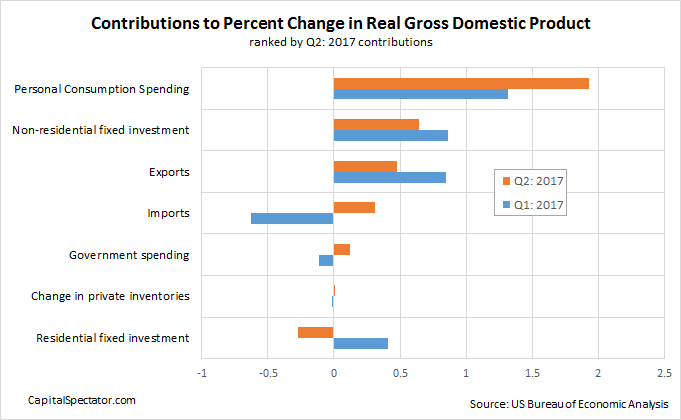Economic activity revived in the second quarter, according to this morning’s “advance” GDP report published by the Bureau of Economic Analysis. Output increased 2.6%, which matched Econoday.com’s consensus forecast. The growth rate also marks an encouraging improvement over Q1’s pace, which was revised down slightly to a sluggish 1.2% rise.
The critical factor in the Q2 rebound is the pick-up in consumer spending. Personal consumption expenditures (PCE) increased 2.8%, up from 1.9% in Q1. The acceleration in PCE was especially pronounced in sales of durable goods, which popped 6.3% in Q2 after a mild 0.1% decline in Q1.
Drilling down into the major categories of GDP contributors shows that the faster rate of consumer spending compensated for relatively weaker inputs from other corners of the economy. PCE’s contribution to GDP picked up to 1.93 percentage points from 1.32 in Q1. Meanwhile, contributions from other key sectors edged lower. Non-residential fixed investment’s contribution ticked down to 0.64 percentage points from 0.86 in Q1. Residential fixed investment was a negative factor in Q2, subtracting 0.27 percentage points from GDP vs. a 0.41 contribution in the previous quarter.
Overall, the resurgence in headline economic growth in Q2 — the strongest quarterly increase since 2016’s Q3 — confirms that 1) recession risk remains low for the immediate future and 2) a moderate pace of growth for Q3 is a reasonable forecast at the moment.
“Consumers continue to drive the economy’s growth, but firmer business investment is also a plus,” says Mark Zandi, chief economist at Moody’s Analytics. “Weaker housing construction was the only significant drag on growth in the quarter.”


Pingback: Economnic Activity Revived in Second Quarter - TradingGods.net
Pingback: Treasury Market Diverges From Stocks… Again - TradingGods.net
Pingback: Rising North Korea Tensions Threaten US Q3 GDP Outlook - Investing Matters
Pingback: US Business Cycle Risk Report | 16 August 2017 - Investing Matters